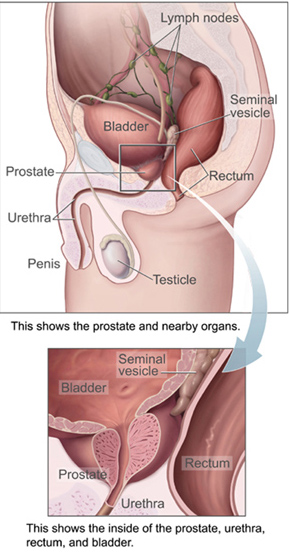Prostate
| Prostate | |
|---|---|

Male Anatomy
|
|

Prostate with seminal vesicles and seminal ducts, viewed from in front and above.
|
|
| Details | |
| Precursor | Endodermic evaginations of the urethra |
| Artery | Internal pudendal artery, inferior vesical artery, and middle rectal artery |
| Vein | Prostatic venous plexus, pudendal plexus, vesical plexus, internal iliac vein |
| Nerve | Inferior hypogastric plexus |
| Lymph | External iliac lymph nodes, internal iliac lymph nodes, sacral lymph nodes |
| Identifiers | |
| Latin | Prostata |
| MeSH | A05.360.444.575 |
| TA | A09.3.08.001 |
| FMA | 9600 |
|
Anatomical terminology
[]
|
|
The prostate (from Ancient Greek προστάτης, prostates, literally "one who stands before", "protector", "guardian") is a compound tubuloalveolar exocrine gland of the male reproductive system in most mammals. It differs considerably among species anatomically, chemically, and physiologically.
The function of the prostate is to secrete a slightly alkaline fluid, milky or white in appearance, that in humans usually constitutes roughly 30% of the volume of the semen along with spermatozoa and seminal vesicle fluid. Semen is made alkaline overall with the secretions from the other contributing glands, including, at least, the seminal vesicle fluid. The alkalinity of semen helps neutralize the acidity of the vaginal tract, prolonging the lifespan of sperm. The prostatic fluid is expelled in the first ejaculate fractions, together with most of the spermatozoa. In comparison with the few spermatozoa expelled together with mainly seminal vesicular fluid, those expelled in prostatic fluid have better motility, longer survival and better protection of the genetic material.
The prostate also contains some smooth muscles that help expel semen during ejaculation.
A healthy human male prostate is classically said to be slightly larger than a walnut. The mean weight of the normal prostate in adult males is about 11 grams, usually ranging between 7 and 16 grams. A study stated that prostate volume among patients with negative biopsy is related significantly with weight and height (Body Mass Index), so it is necessary to control for weight. The prostate surrounds the urethra just below the urinary bladder and can be felt during a rectal exam.
...
Wikipedia
